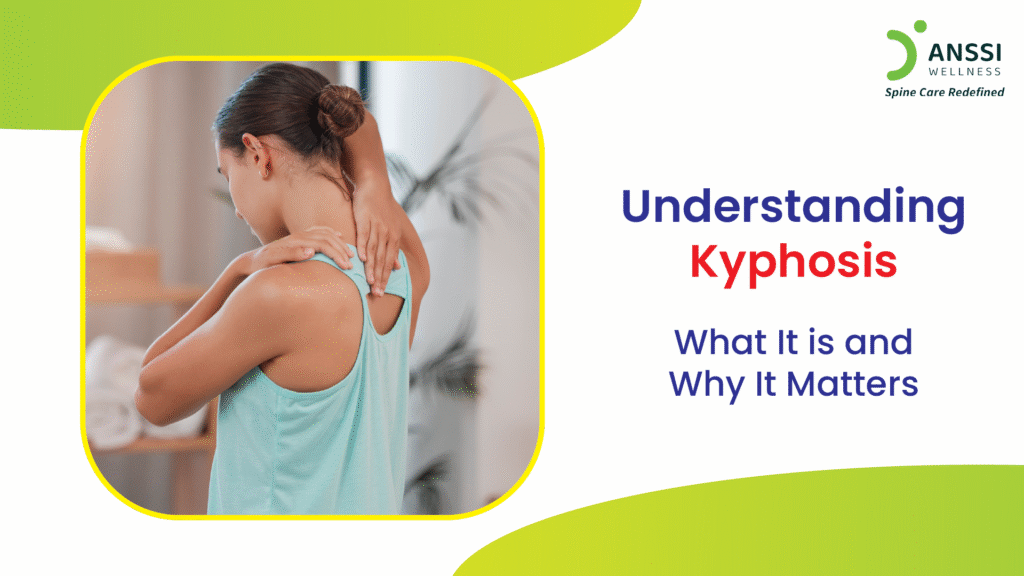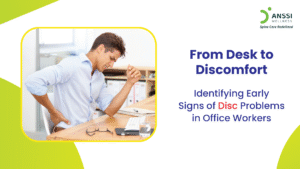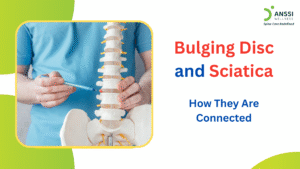Kyphosis is a spinal condition that often goes unnoticed until it causes visible postural changes or persistent back pain. Characterised by an excessive forward curve of the upper spine, kyphosis can affect people of all ages and significantly impact spinal health and posture.
While mild cases may cause little discomfort, more pronounced curvatures can lead to serious health issues, including breathing difficulties and nerve-related symptoms. Early understanding and intervention are essential in managing this condition effectively.
What is Kyphosis?
Kyphosis refers to an abnormal rounding of the upper back, where the spine develops a curve of more than 50 degrees. Some curvature in the thoracic spine is normal, but when the curve becomes exaggerated, it is classified as kyphosis. This condition can affect the way a person walks, sits, and performs daily activities.
There are three main types of kyphosis:
- Postural Kyphosis: The most common form, often seen in adolescents and caused by poor posture or slouching
- Scheuermann’s Kyphosis: A more structural and rigid form, often developing during adolescence due to abnormal growth of spinal vertebrae
- Congenital Kyphosis: A rare form present at birth, caused by malformation of the spine during fetal development
Each type of kyphosis has its own underlying causes and severity levels, requiring different approaches to treatment and care.
Visible Signs and Symptoms
In its early stages, kyphosis may not cause any symptoms. However, as the curvature progresses, several physical signs and discomforts can emerge:
- A rounded or hunched upper back
- Forward head posture
- Slumped shoulders
- Fatigue or muscle weakness, especially in the upper back
- Mild to moderate back pain and stiffness
- Reduced mobility in the upper spine
- In severe cases, difficulty in breathing, numbness, or tingling due to nerve compression
In children and teenagers, postural kyphosis may develop gradually due to prolonged slouching, particularly while sitting at desks or using digital devices. In older adults, kyphosis is often associated with age-related spinal degeneration, including osteoporosis.
Impact on Posture and Spine Health
Kyphosis affects more than just appearance. The spinal column is central to our body’s alignment and mobility. When the upper back curves excessively forward, it disrupts the natural curvature of the spine, causing a chain reaction throughout the musculoskeletal system.
Over time, the abnormal curvature can:
- Place extra strain on spinal discs, muscles, and ligaments
- Contribute to chronic back or neck pain
- Limit range of motion in the spine and shoulders
- Increase risk of falls due to imbalanced posture
- Lead to compression of the lungs or digestive organs in severe cases
Additionally, poor posture associated with kyphosis can cause psychological distress, especially in teenagers and young adults, affecting self-confidence and mental well-being.
Why Early Awareness Matters
Like many spinal conditions, kyphosis responds best to early intervention. Identifying and addressing postural habits, musculoskeletal imbalances, or underlying spinal disorders early on can slow or even reverse progression, especially in flexible types like postural kyphosis.
Here’s why early awareness is critical:
- Prevent progression: Mild curvature can often be corrected with physiotherapy and posture training before it worsens.
- Avoid complications: Timely treatment can prevent complications such as nerve compression, lung function impairment, and chronic pain.
- Improve quality of life: Addressing symptoms early improves daily functioning and long-term mobility.
A proactive approach through diagnosis, lifestyle changes, and proper treatment can significantly reduce the long-term impact of kyphosis.
Non-Surgical Treatment Options
Most cases of kyphosis, especially mild to moderate ones, can be managed without surgery. A combination of conservative, non-invasive therapies can help relieve symptoms, improve posture, and restore spinal alignment.
1. Physiotherapy
A targeted exercise program designed by a physiotherapist can strengthen the back and abdominal muscles, improve posture, and increase spinal flexibility. Common exercises include back extensions, shoulder blade squeezes, and core strengthening routines.
2. Posture Correction
Educating patients about posture and ergonomics is key to managing kyphosis.
Techniques include:
- Keeping the shoulders relaxed but pulled slightly back
- Aligning the ears over the shoulders
- Avoiding prolonged slouching while sitting or using electronic devices
3. Lifestyle Adjustments
Simple changes such as regular movement breaks, ergonomic seating, and avoiding heavy lifting can prevent postural strain and support spinal health.
4. Bracing (for Adolescents)
In younger individuals with Scheuermann’s kyphosis, a brace may be prescribed to help guide spinal growth and prevent further curvature.
About ANSSI:
ANSSI Wellness focuses on improving the quality of life for patients suffering from spinal issues, aiming to provide relief where other conventional treatments have failed. Through advanced non-surgical spinal decompression treatment, ANSSI is committed to helping patients avoid surgery and recover in a safe, effective, and compassionate environment.
Connect with ANSSI Wellness on LinkedIn, Instagram, and Facebook for expert guidance.




